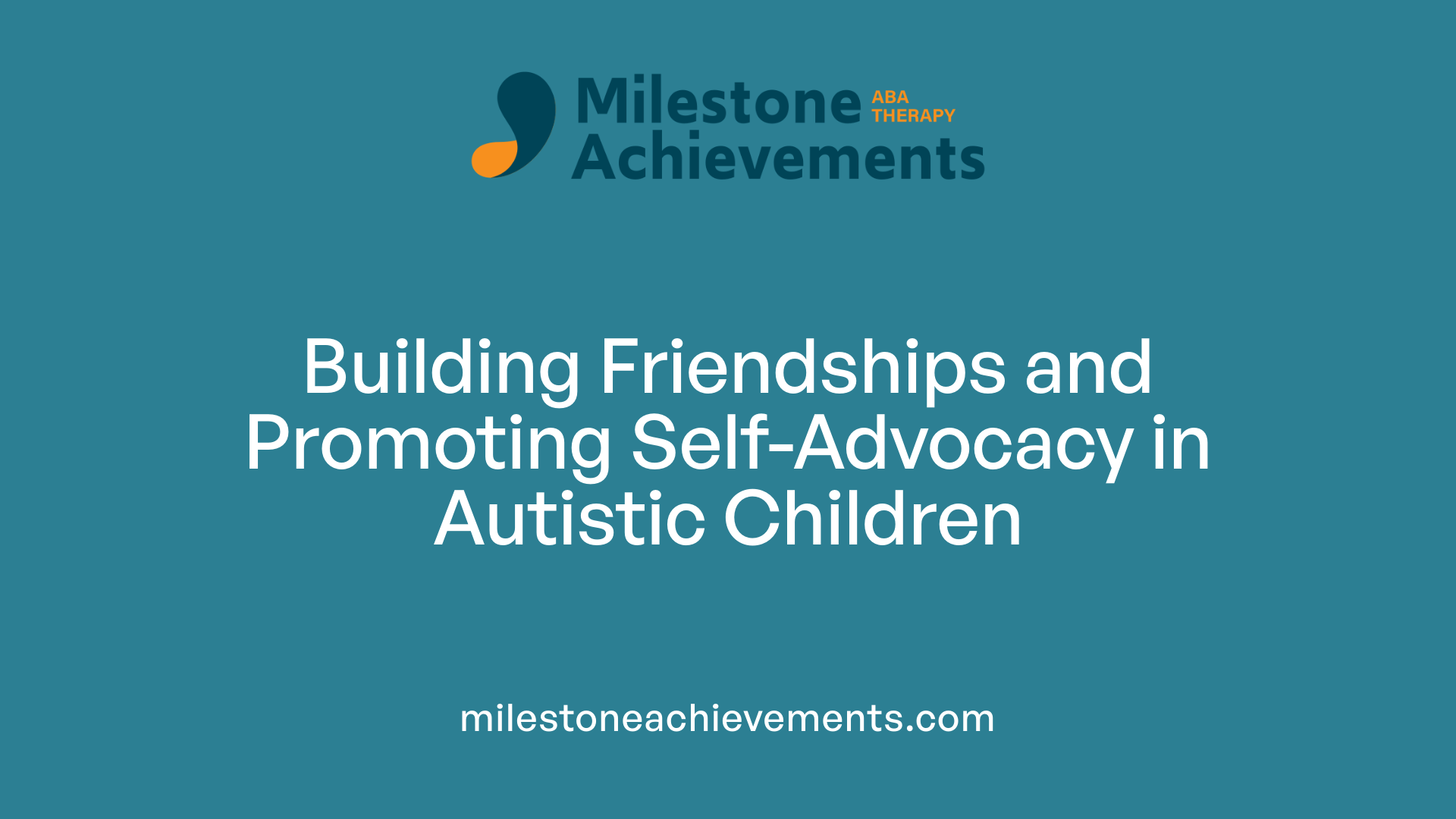
How to Support Autistic Children in Mainstream Schools
Promoting Inclusivity and Support for Autistic Children in Schools
Understanding the Foundations of School Support for Autistic Students
Supporting autistic children in mainstream schools requires a comprehensive understanding of their unique strengths, challenges, and the environment. Over 70% of autistic children are educated in mainstream settings, yet many face barriers related to sensory sensitivities, social interactions, and communication differences. Effective support involves policies, classroom adaptations, and collaboration among educators, families, and specialists. This article explores best practices, resources, and systemic approaches to foster successful inclusion and empower autistic children to thrive.
Legislative Policies and Support Services for Inclusive Education

What policies and support services are available to help autistic children succeed in mainstream education?
Supporting autistic children in mainstream schools relies on a combination of policies, programs, and tailored interventions designed to meet their diverse needs.
A foundational element is the use of Individualized Education Plans (IEPs). These legal documents outline specific goals, accommodations, and support services tailored to each child's unique profile. They ensure that schools are legally obliged to provide necessary modifications, such as extra time for tasks, sensory accommodations, or specialized instruction.
Many schools also implement evidence-based programs to enhance support. The TEACCH Structured Teaching model emphasizes visual supports, structured routines, and clear cues, helping children with autism navigate daily classroom activities confidently. The Incredible Years Teacher Autism program equips educators with strategies to promote positive behaviors, social skills, and engagement.
Sensory accommodations are vital, especially considering the sensory sensitivities common among autistic children. Schools often provide quiet zones, sensory tools like fidget toys, noise-canceling headphones, and adjustable lighting to create a sensory-friendly environment.
Behavioral interventions focus on positive reinforcement techniques, social stories, visual schedules, and consistent routines to reduce anxiety and meltdowns. These strategies help students develop self-regulation skills and better adapt to classroom expectations.
Promoting peer understanding and relationships is also crucial. Activities such as group work, buddy systems, and social skills groups foster inclusion and improve social acceptance. Encouraging self-advocacy skills and independence further empower students to participate actively in their learning.
Effective teacher training is essential for the success of inclusive education. Ongoing professional development on autism awareness, behavioral management, and classroom differentiation enables educators to apply best practices. Collaboration with families through regular communication, shared planning, and parent feedback ensures that support remains consistent and responsive.
Creating sensory-friendly, flexible environments, coupled with comprehensive policies and support services, can significantly improve outcomes for autistic children, allowing them to thrive socially, emotionally, and academically in mainstream settings.
Implementing Effective Classroom Strategies
What are effective strategies for supporting autistic children in inclusive, mainstream classrooms?
Supporting autistic children in mainstream settings means adopting tailored and proactive strategies to meet their diverse needs. Visual supports like picture schedules, social stories, and emotion charts help children understand routines and social expectations, reducing anxiety and confusion.
Structured routines and clear expectations are vital. Using visual cues and timers can facilitate transition between activities and establish predictability. Additionally, creating a sensory-friendly classroom environment—such as designated quiet areas, noise-canceling headphones, and adjustable lighting—minimizes sensory overload.
Teachers can employ evidence-based teaching models like TEACCH or Pivotal Response Treatment, which focus on individual strengths and functional skills. Positive reinforcement encourages desirable behaviors and promotes engagement. Integrating social skills groups and peer mentoring fosters social interaction, acceptance, and friendship formation.
Supporting autistic children also involves consistent collaboration with families, therapists, and specialists. Regular communication ensures classroom strategies remain aligned with each child's evolving needs. Ongoing teacher training on autism awareness and inclusive practices is essential, empowering educators to create supportive, accommodating environments.
In summary, implementing a combination of visual supports, structured routines, sensory accommodations, and inclusive social activities helps autistic children thrive in mainstream classrooms. These strategies promote not only learning and participation but also social integration and overall well-being.
Classroom Accommodations and Modifications

What accommodations and classroom modifications can support autistic students in mainstream schools?
Supporting autistic students effectively involves a range of tailored adjustments that address their unique sensory, communication, and behavioral needs. These modifications help create an inclusive environment where all children can thrive academically and socially.
One of the most important strategies is using sensory processing techniques. Sensory aids such as noise-canceling headphones, dim lighting, and designated quiet areas help regulate sensory overload—a common challenge for autistic children. Sensory breaks and sensory-friendly spaces allow students to self-soothe and regain focus, reducing anxiety and meltdowns.
Visual supports like schedules, social stories, and clear visual cues are fundamental tools. Visual schedules outline daily routines, helping children anticipate what’s next and reducing stress. Social stories teach appropriate social behaviors through simple narratives, easing social interactions and building confidence.
Classroom modifications include flexible seating arrangements—such as bean bags, standing desks, or calming corners—and small group instruction to promote engagement and individualized attention. These setups help accommodate sensory sensitivities and working styles.
Assistive technology, including augmentative and alternative communication (AAC) devices, can facilitate communication for children with speech or language difficulties. Technology tools support understanding and expression, enabling better participation in lessons.
Behavioral supports like peer buddy programs, positive reinforcement strategies, and social skills training foster social inclusion and reduce anxiety. Regular collaboration among teachers, therapists, and families ensures that these accommodations evolve with the child's development.
In sum, implementing an array of sensory strategies, visual supports, flexible learning options, assistive technology, and social supports creates an environment where autistic students can access the curriculum comfortably and confidently, paving the way for successful inclusion.
Addressing Challenges: School Refusal and Disruptive Behaviors

What are common challenges faced by autistic children in school, such as school refusal or disruptive behaviors, and how can they be addressed?
Autistic children frequently encounter difficulties such as school refusal and disruptive behaviors. These issues often originate from sensory overload, heightened anxiety, and challenges with adapting to new or unpredictable environments. For example, loud noises, bright lights, and crowded spaces can overwhelm their sensory systems, leading to stress and withdrawal.
Disruptive behaviors might also stem from communication difficulties or frustration when they cannot express their needs effectively. When schools lack understanding or appropriate support, these behaviors can be misunderstood, resulting in exclusion or negative experiences that increase trauma.
To effectively address these challenges, schools should foster supportive and predictable settings. Implementing personalized support plans, such as Individual Education Plans (IEPs), ensures that each child's specific needs are met through tailored accommodations. Creating a calm, sensory-friendly environment with designated quiet areas helps children manage sensory overload and regain composure.
Building routines and clear expectations reduces anxiety by providing structure. Visual schedules, social stories, and advance notice of changes help autistic children anticipate and prepare for routines, reducing stress and resistance.
A trauma-informed approach is vital. Recognizing that negative experiences in school can lead to trauma, staff should adopt patience and sensitivity, emphasizing trust and safety. Training staff in autism awareness and positive behavior support fosters understanding and reduces misinterpretations of behavior.
Early intervention is essential, ideally involving multidisciplinary teams that include therapists, educators, and families. Systemic reforms, such as staff training, policy adjustments, and inclusive curricula, are necessary to create genuinely accepting learning environments.
Ultimately, collaboration between families and schools ensures consistency and support continuity. Regular communication, shared goals, and mutual understanding help address disruptive behaviors effectively, enabling autistic children to thrive academically, socially, and emotionally in school settings.
Supporting Non-verbal Autistic Children

How can schools support non-verbal autistic children in mainstream settings?
Supporting students who are non-verbal in mainstream schools requires a tailored approach that emphasizes effective communication methods. Schools can incorporate various assistive tools, such as picture exchange systems (PECS), visual boards, sign language, and speech-generating devices, to facilitate interaction. These tools help children express their needs and participate actively in classroom activities.
High-tech communication devices, including tablets loaded with AAC (Augmentative and Alternative Communication) apps like Proloquo2Go or TouchChat, play a vital role. They offer a powerful means for children to generate speech and connect with peers and teachers, especially when used alongside modeling and prompting strategies.
Visual supports are also essential. Visual schedules, social stories, and visual cues support understanding of routines, social cues, and expectations. They foster independence and boost confidence, helping children navigate social interactions and classroom activities.
Collaborating with speech-language pathologists (SLPs) is crucial to identify the most suitable communication tools for each child. SLPs provide assessments, recommend appropriate devices, and offer training to staff and peers, ensuring everyone understands how to support communication effectively.
Training programs that teach staff and students how to implement and utilize these communication strategies are vital. Consistent use and reinforcement of communication tools promote better social interactions, build trust, and enhance educational participation.
Ultimately, integrating these strategies creates a supportive environment where non-verbal autistic children can thrive socially and academically in mainstream classrooms, fostering inclusion and mutual understanding.
Fostering Social Acceptance and Individual Growth

Building friendships and peer acceptance
Supporting autistic children in developing friendships is vital. Social skills groups, peer mentoring, and structured activities can help children initiate and maintain friendships. Understanding body language, turn-taking, and emotional regulation are fundamental skills that can be taught explicitly.
Mainstream classrooms with inclusive practices promote social acceptance as neurotypical peers learn empathy and understanding. Over time, this creates friendships that strengthen confidence and belonging.
Encouraging self-advocacy and independence
Teaching autistic children to understand and communicate their needs fosters independence. Using visual aids like social stories and emotion scales helps children recognize their feelings and express preferences.
Encouraging self-advocacy skills—such as asking for help or using alternative communication methods—empowers children. Supporting their independence not only benefits their personal growth but also prepares them for future educational and social environments.
Promoting positive attitudes among peers
Educating all students about autism fosters empathy and reduces stigma. Peer awareness programs, inclusive activities, and classroom discussions about diversity promote understanding.
Positive experience with classmates and teachers helps change attitudes, which encourages acceptance and reduces bullying or social exclusion.
Supporting transitions and future planning
Transitioning from primary to secondary school, or to college, involves careful planning. Visual schedules, social stories, and gradual exposure lessen anxiety.
Supporting children with transition plans tailored to individual needs ensures they are prepared for new routines, environments, and social settings. Collaboration among families, schools, and support services creates smooth transitions.
Role of family involvement and community support
Parents play a crucial role by advocating for their children and collaborating with educators. Regular communication, sharing insights about the child's strengths and challenges, and participating in school activities foster a supportive environment.
Community programs and local autism networks offer additional resources, social opportunities, and advocacy. A strong partnership among families, schools, and community organizations enhances the overall development and social inclusion of autistic children.
Moving Towards More Inclusive and Supportive Education
Supporting autistic children in mainstream schools is a shared responsibility that requires policies, effective strategies, accommodations, and a nurturing environment. Systemic reforms, ongoing professional development, and strong collaboration among educators, families, and support services are essential to ensure every autistic child has the opportunity to succeed academically, socially, and emotionally. By fostering understanding and implementing individualized, flexible supports, educational settings can become truly inclusive spaces where autistic children thrive, build meaningful relationships, and develop lifelong skills.
References
- How to support a child with autism in the classroom | Autism Speaks
- Supporting autistic children to stay in mainstream education
- Advice about school if your child is autistic - NHS
- Supporting an Autistic Child in Mainstream School
- Can an Autistic Child Go to Normal School?
- Understanding Parents' Experiences With Mainstream Schooling for ...
- Educating Autistic Children - American Federation of Teachers
- Different classroom options | Autism Awareness Australia
- How Can We Prepare A Child with Autism Into Mainstream Schools?
- Autistic children's sensory 'tactics' for navigating mainstream school ...


Partner with us on your child's journey
Milestone Achievements offers evidence-based ABA therapy to help children with autism reach their full potential. Together we’ll set meaningful goals and celebrate progress every step of the way.
Start ABA Services Today


